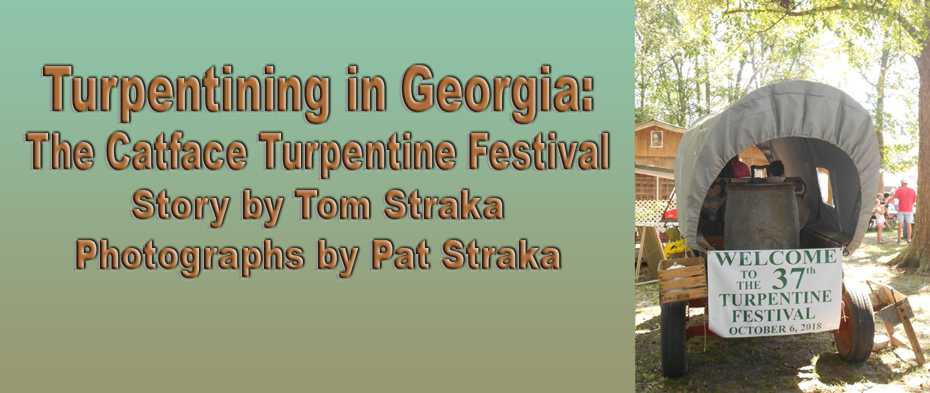|
My spell checker
tells me I have two suspicious words in the
title. It has not heard of turpentining or a
catface. Many of the readers can probably figure
out what the former means, but I bet they don’t
know what the latter is. There are lots of
festivals across the country which provide a
travel adventure immersed in local history and
folk culture. The CatfaceTurpentine Festival
held annually in early October in Portal,
Georgia is one of those. The 37th one was held
this year, so the folks of Portal have some
experience putting on this festival. It’s a
standard rural festival, starting with a parade
that includes every local vehicle with a siren
and, of course, Miss Turpentine, arts and
crafts, a cake walk, all kinds of unhealthy
food, children’s rides and games, live
entertainment, ending with a street dance. This
one is different because it embraces the local
history of a fascinating industry and has an
operating turpentine still as the center
attraction.
 |
|
The festival begins with a typical
small-town parade. |
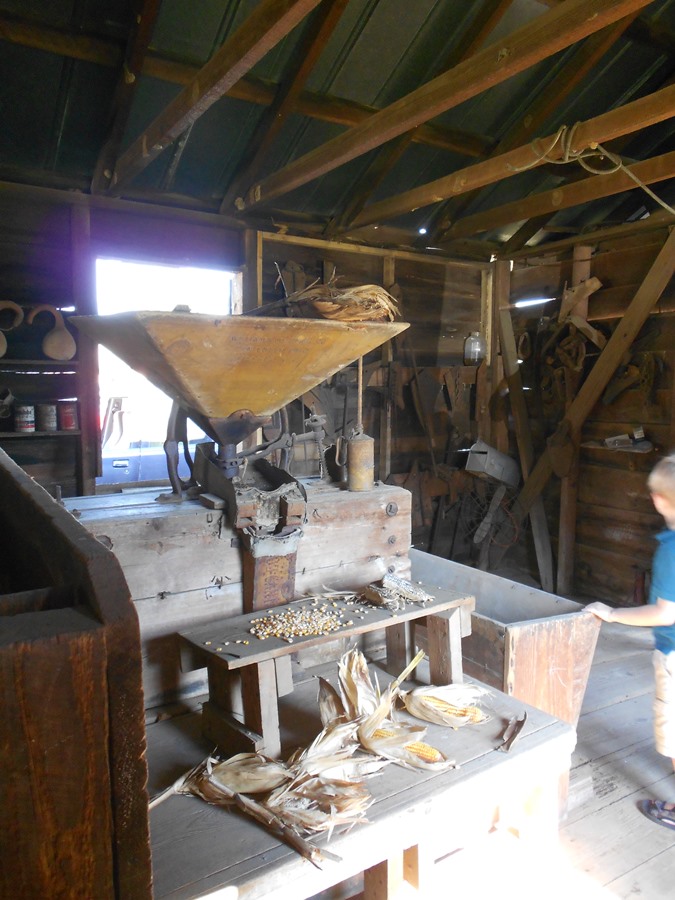 |
|
Carter’s General Store has a
museum out back that includes a grist
mill. |
The Naval Stores Industry
First, some brief
history and technical detail. Turpentine is a
product of the naval stores industry. Naval
stores was one of North America’s first
industries and involved utilization of southern
pines for their resinous sap. As early as 1608
Virginia producers were sending pitch and tar
from pine trees to England. The term “naval
stores” comes from the use of pitch and tar for
waterproofing ship hulls and decks and for
preserving ship’s rigging. Even after its use
for naval purposes diminished, the term
persisted to describe the industry.
Turpentining
refers to collecting crude gum from “tapped”
living pine trees by removing a portion of the
bark, causing the tree to secrete gum that is
collected and distilled into spirits of
turpentine and rosin. That living tree was
usually the resinous longleaf pine, sometimes
slash pine, causing the industry to be located
near the southern coast ranging from Virginia to
Texas. The process began with “boxing” the trees
by using long-headed axes to cut an elliptical
hole, roughly eight to twelve inches wide and
four to five inches deep at the base of the tree
trunk. This formed a cavity used to collect the
resin. Next, the box was “cornered” by removing
bark in a triangular pattern on each side of the
top of the box. These slash marks resembled
whiskers on a cat’s face, creating the term
“catface” for the wound on the tree. The tree
naturally secreted sap or gum as protection from
insects and disease due to the wound. About
every ten days the turpentiner returned and cut
a new streak on the catface with a tool called a
hack -- called “chipping.” At the same time
resin was dipped from the boxes and collected in
barrels strategically located in the forest for
later transport to a distillery. A turpentiner
would chip and dip a “crop” of 10,000 catfaces
in a season (from April to October) with a yield
of 150 barrels of gum turpentine. The process
was labor-intensive and would eventually kill
the trees. As forests were depleted turpentiners
would have to move to new regions of the South.
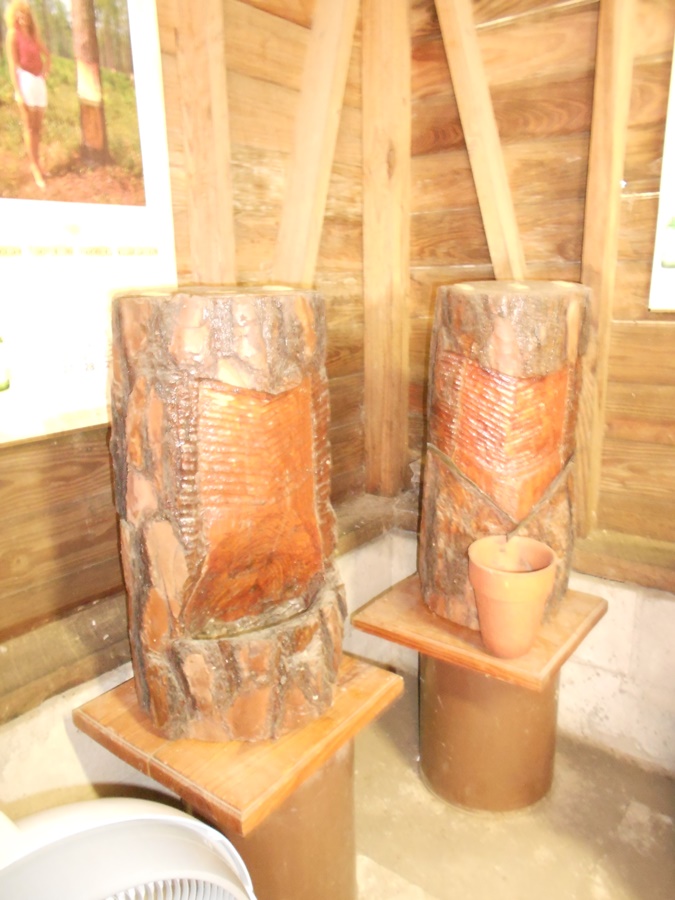 |
|
Examples of catfaces from the
Turpentine Museum. |
At the distillery
the gum was transformed into turpentine and
rosin. The gum was loaded from the barrels into
the still, mixed with a small amount of water,
and heated in a copper still until the mixture
began to boil (similar to a whiskey distillery).
Vapor would flow through tubing (a copper worm)
where it was cooled by water, would condense,
and be dripped into a collection barrel as
spirits of turpentine. The mixture would contain
both water and turpentine, and laborers would
skim turpentine from the surface. This was
called gum turpentining. Rosin would congeal at
the bottom of the still and a tap would allow it
to flow into a trough for collection. The master
distiller knew when to add more water or
increase the heat from sounds made by the worm
or the boiling gum. The process took from four
to six hours and shown in all its glory at the
festival.
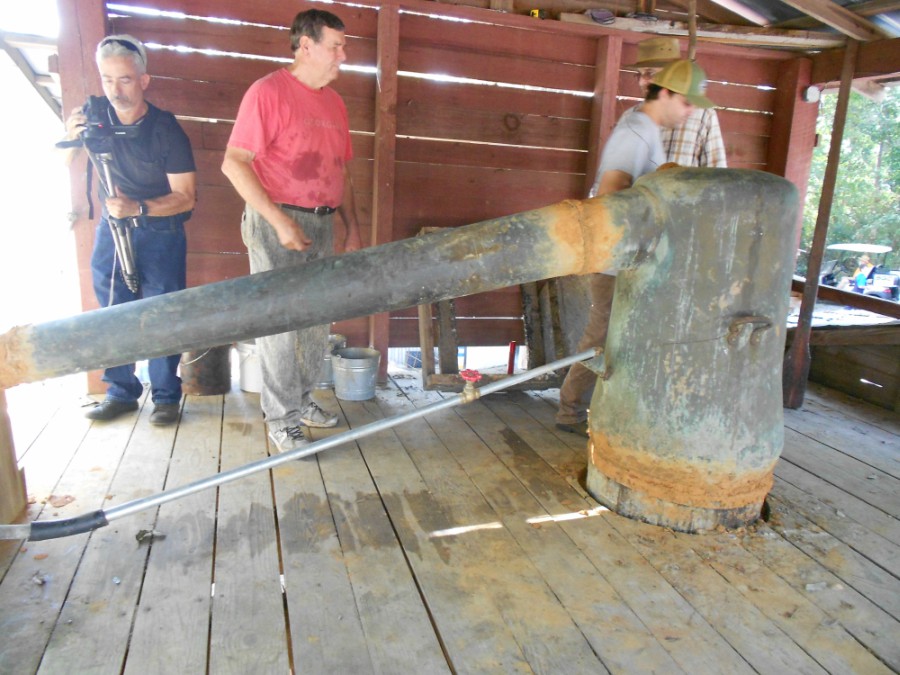 |
|
The still in operation. |
|
|
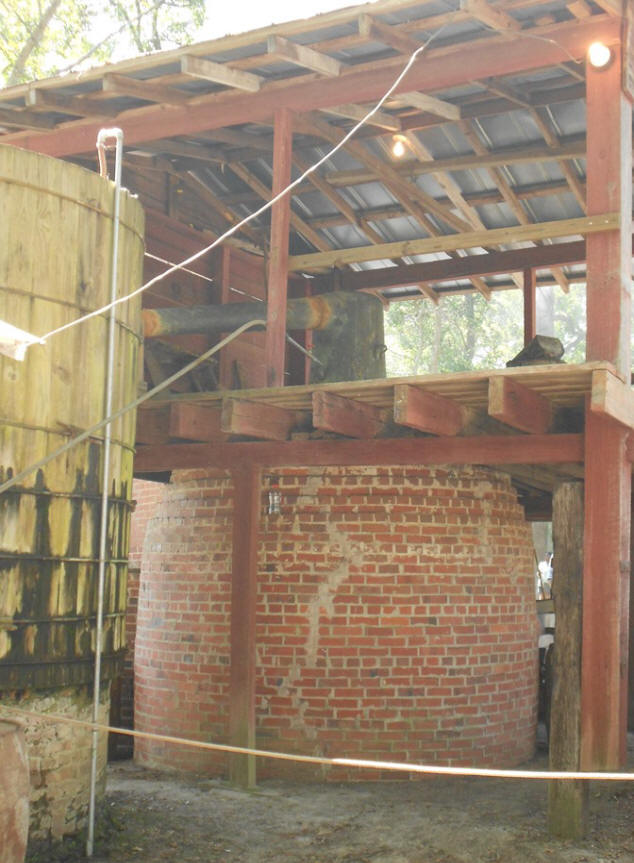 |
|
The entire still from the ground. |
The Portal
Heritage has the official history, which starts
with “in the beginning” and described how the
commercial turpentine still came to be:
The turpentine
industry in Bulloch County's town of Portal
began with F.N. Carter, Sr., and his son E. C.
Carter, who owned and operated a commercial
turpentine still from the 1930's until the
1960's. Then, for nearly 20 years, the Carter
still was cold and silent. While many stills
from that period were dismantled and parts were
sold for the copper tubing and iron boilers, the
Carter Still remained as it was and on its
original site.
IIn 1982, Denver
Hollingsworth and the Portal Heritage Society
suggested restoring the old Carter turpentine
still; and with much work and dedication from
the community, the old still was restored and,
once again, the old boiler was lit. The Carter
turpentine still is only one of three turpentine
stills remaining in the State of Georgia. The
two other remaining stills are located in Tifton
and Walthourville.
The turpentine
process begins with harvesting pine tar/gum from
"Slash Pine" trees. Turpentine harvesters cut
slash marks into the sides of pine trees, and
the tar/gum slowly leaks into metal vats placed
at the bottom of the slash marks. The slash
marks resemble whiskers on a cat's face, thus
the term "Catface Country" was adopted for
Portal's annual Turpentine Festival. After
collection of the pine tar is completed, it is
"cooked down" at the still to result in
turpentine.
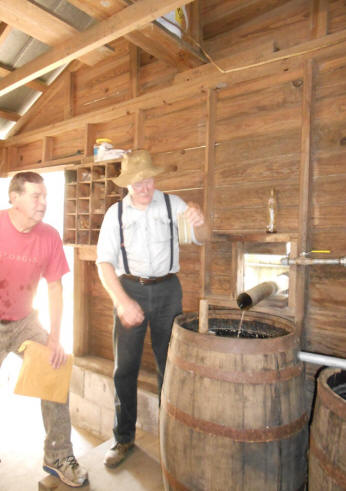 |
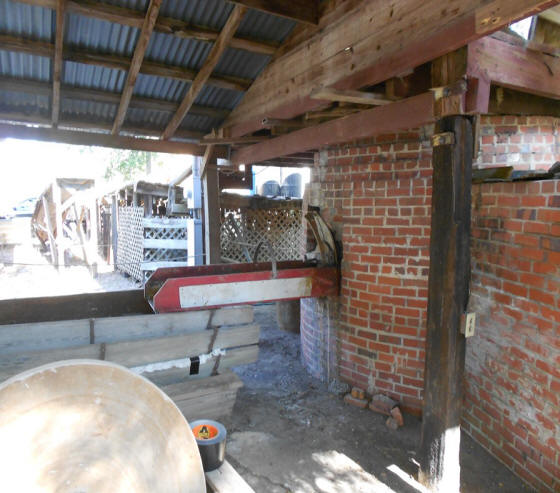 |
|
The spirits of turpentine flows from the
still tubing into a barrel. |
The rosin is collected from the still at
the opposite side
from the turpentine.
|
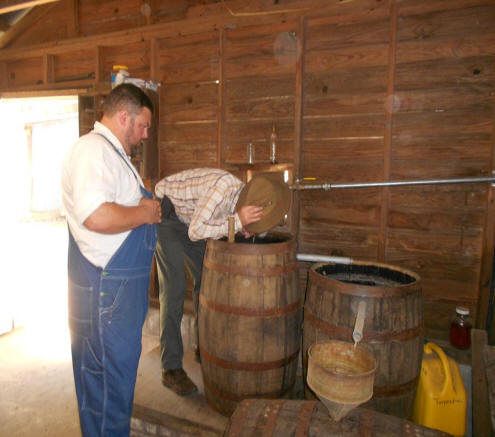 |
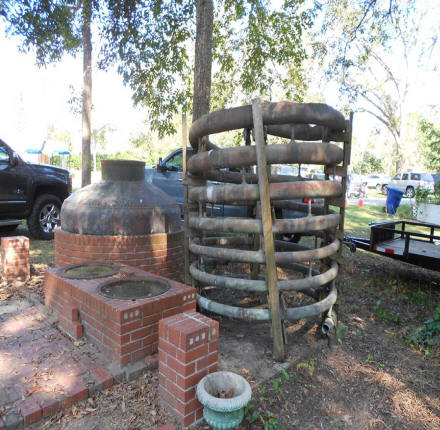 |
|
Apparently quality can be judged by the
smell. |
An example of the type of tubing used in
the still. |
The Festival
What to expect?
The official spiel is: “The festival begins with
a parade along U. S. Highway 80, which runs
through downtown Portal. At the conclusion of
the parade, visitors gather at the festival
grounds nearby to browse through the various
booths of arts and crafts, and to enjoy rides,
games, delicious foods, and a variety of
entertainment. For those interested in the
history of turpentine, a demonstration of how
the old still works is presented, and visitors
can enjoy the unique "rosin-baked" potatoes.”
The parade is led
(loudly) by lots of emergency vehicles, followed
by bands, many Miss Turpentine Queens, very
local celebrities, and a float or two. Across
from where we watched the parade was Carter’s
General Store. It turned out to be more of an
antique store, but outback was an interesting
small museum with farming and turpentine items
(including an example of a catface to get things
going). It’s a small town and the parade route
is walking distance to the festival grounds. The
festival includes all the food, entertainment,
arts and crafts, and children’s attractions
you’d expect at a local event like this.
The truly
different part is the turpentine stuff: the
still, turpentine museum, and the rosin
potatoes. We’ll start with the potatoes, as it
is kind of fascinating to think of cooking a
potato in boiling pine rosin. It must have been
a desperate forest worker who first tried it,
but supposedly the rosin distributes the heat
exceptionally well around the potato producing a
truly delicious treat. The potatoes (both
regular ones and sweet potatoes) are boiled in
rosin heated to 350 degrees and cooked for an
hour. You can’t eat the skin with this cooking
method due to the rosin, but the potatoes come
out tasting fine.
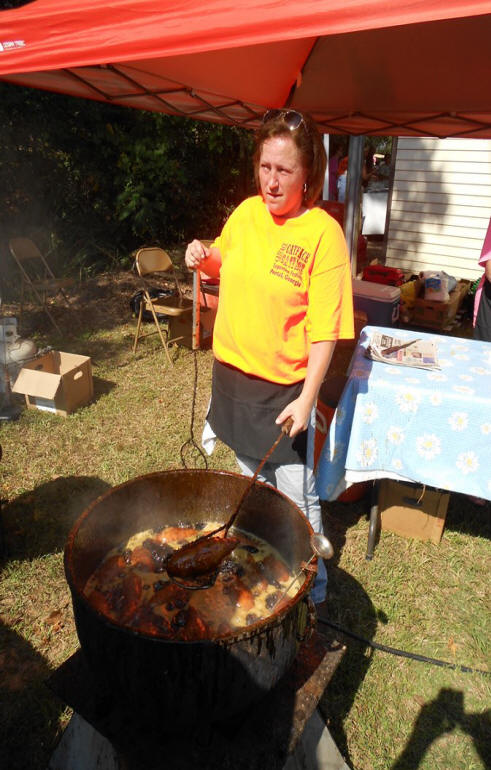 |
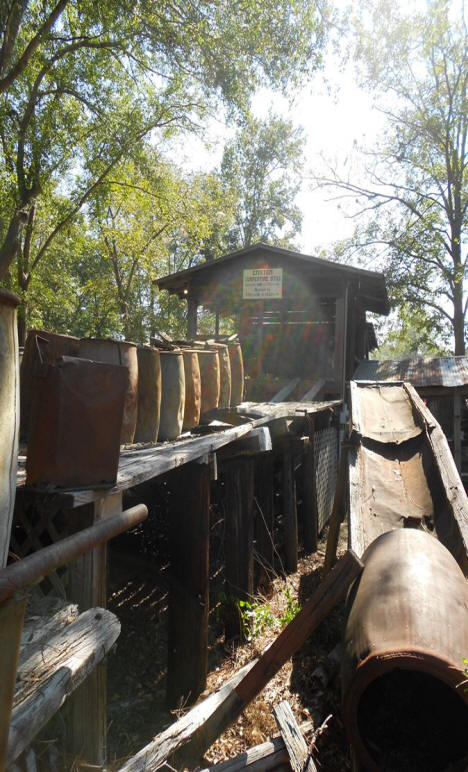 |
Rosin potatoes being prepared,
both sweet potatoes and regular ones are
sold. |
The Carter Turpentine Still with
barrels. |
Saving the best
for last, that would be the Carter Turpentine
Still and the adjacent Turpentine Museum. There
are about three operating turpentine stills in
the state; this is the only one on its original
site. And during the festival it is truly
operational. Turpentine comes out one end and
rosin out the other. The master turpentiner will
give a tour of the still if asked, but only to a
couple at a time as the space is small and the
still is actually operating. The turpentine
coming from the still flows into a barrel in the
museum. Rosin flows in the opposite direction
late in the day at the end of the process. All
the operational parts of the still are there,
including displays of operating parts
of the still and turpentine barrels. The museum
has an assortment of turpentining tools and all
sorts of related items, including displays of
what a catface looks like.
It’s a wonderful
way to spend a day learning about southern
culture, turpentine history and technology,
listening to good music, and trying to avoid too
much tempting food.
Authors: Thomas J. Straka is a
forestry professor at Clemson University in
South Carolina. His wife, Patricia, is a
consulting forester. Both have a keen interest
in history.
For additional information:
Festival video:
http://www.wtoc.com/story/30174151/portal-firing-up-turpentine-still-to-celebrate-a-piece-of-southern-history/
Turpentine Museum
video:
http://www.wtoc.com/clip/11886744/portal-turpentine-museum-named-for-longtime-volunteer/?autostart=true
Rosin potatoes:
https://thecookscook.com/features/the-almost-lost-art-of-rosin-potatoes/
Rosin potatoes:
http://www.hungrybrowser.com/phaedrus/mprosinpotatoes.htm |

